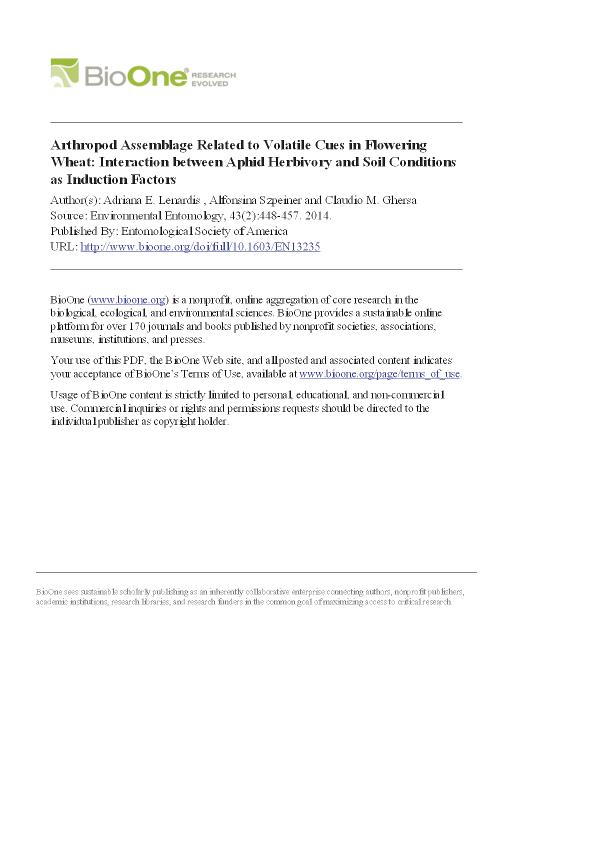Mostrar el registro sencillo del ítem
dc.contributor.author
Lenardis, Adriana Ester
dc.contributor.author
Szpeiner, Alfonsina

dc.contributor.author
Ghersa, Claudio Marco

dc.date.available
2016-02-17T20:44:59Z
dc.date.issued
2014-04
dc.identifier.citation
Lenardis, Adriana Ester; Szpeiner, Alfonsina; Ghersa, Claudio Marco; Arthropod assemblage related to volatile cues in flowering wheat: interaction between aphid herbivory and soil conditions as induction factors; Oxford University Press; Environmental Entomology; 43; 2; 4-2014; 448-457
dc.identifier.issn
0046-225X
dc.identifier.uri
http://hdl.handle.net/11336/4235
dc.description.abstract
Volatile cues released by plants play an important role in plant-insect interactions and are influenced by pests or soil conditions affecting plant metabolism. Field microcosm experiments were used to characterize arthropod spontaneous assemblies in homogenous unstressed wheat patches exposed to volatile cues coming from wheat plants with different levels of stress. The design was a factorial completely randomized block design with three replications. Source wheat pots combined two stress factors: 1) soil degradation level: high and low, and 2) aphid herbivory: with (A) and without (B). Eighteen experimental units consisted of source stressed wheat pots, connected by tubes conducting the volatile cues to sink wheat patches. These patches were located at the end of the tubes placed in a flowering wheat field. Arthropod assemblies on wheat sinks were different between years and they were associated to the source cues. Soil condition was the main discriminating factor among arthropods when a clear contrast between high and low soil degradation was observed, whereas aphid herbivory was the main discriminating factor when soil condition effects were absent. Main soil properties related with arthropods assembly were Mg and K in the first year and cation exchange capacity, total nitrogen, and pH in the second year of experiment. According to this study, spontaneous arthropod distributions in the homogeneous, unstressed wheat patch responded to the volatile cues coming from wheat sources growing in particular soil conditions. It is possible to suggest that soil-plant-herbivore interactions change wheat cues and this phenomenon produces significant differences in neighboring arthropod community structure.
dc.format
application/pdf
dc.language.iso
eng
dc.publisher
Oxford University Press

dc.rights
info:eu-repo/semantics/openAccess
dc.rights.uri
https://creativecommons.org/licenses/by-nc-sa/2.5/ar/
dc.subject
Herbivory
dc.subject
Soil Degradation
dc.subject
Volatile Compound
dc.subject
Arthropods Community
dc.subject
Plant Defense
dc.subject.classification
Agricultura

dc.subject.classification
Agricultura, Silvicultura y Pesca

dc.subject.classification
CIENCIAS AGRÍCOLAS

dc.title
Arthropod assemblage related to volatile cues in flowering wheat: interaction between aphid herbivory and soil conditions as induction factors
dc.type
info:eu-repo/semantics/article
dc.type
info:ar-repo/semantics/artículo
dc.type
info:eu-repo/semantics/publishedVersion
dc.date.updated
2016-03-30 10:35:44.97925-03
dc.journal.volume
43
dc.journal.number
2
dc.journal.pagination
448-457
dc.journal.pais
Reino Unido

dc.journal.ciudad
Oxford
dc.description.fil
Fil: Lenardis, Adriana Ester. Universidad de Buenos Aires. Facultad de Agronomia. Departamento de Producción Vegetal. Cátedra de Produccion Vegetal; Argentina
dc.description.fil
Fil: Szpeiner, Alfonsina. Consejo Nacional de Investigaciones Científicas y Técnicas. Oficina de Coordinación Administrativa Parque Centenario. Instituto de Investigaciones Fisiológicas y Ecológicas Vinculadas a la Agricultura; Argentina. Universidad de Buenos Aires. Facultad de Agronomia. Departamento de Recursos Naturales y Ambiente; Argentina
dc.description.fil
Fil: Ghersa, Claudio Marco. Consejo Nacional de Investigaciones Científicas y Técnicas. Oficina de Coordinación Administrativa Parque Centenario. Instituto de Investigaciones Fisiológicas y Ecológicas Vinculadas a la Agricultura; Argentina. Universidad de Buenos Aires. Facultad de Agronomia. Departamento de Recursos Naturales y Ambiente; Argentina
dc.journal.title
Environmental Entomology

dc.relation.alternativeid
info:eu-repo/semantics/altIdentifier/url/https://ee.oxfordjournals.org/content/43/2/448.long
dc.relation.alternativeid
info:eu-repo/semantics/altIdentifier/doi/http://dx.doi.org/10.1603/EN13235
dc.relation.alternativeid
info:eu-repo/semantics/altIdentifier/issn/0046-225X
Archivos asociados
